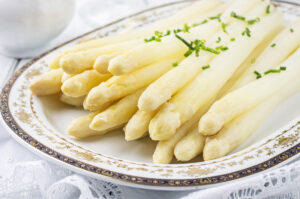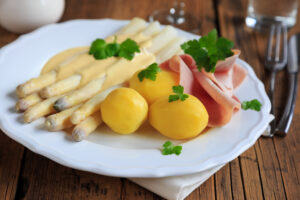It’s that special time of year dedicated to celebrating Germany’s favorite vegetable.
By Audra Grigus

The beloved Spargelzeit (asparagus season) is upon us, a time when Germans eat as much “white gold” as they can before the season ends.
The Spargel season is relatively short in Germany, running from mid-April to June 24. If Spargel is harvested too late in the season, the root may be killed by the harsh summer heat. It is best if the asparagus root stays protected in the ground for the next season. Older Spargel farmers have a saying, “When the cherries get red, leave the asparagus in its bed.”
But… Why is Spargel white and why do Germans love it so much?
The main difference between the thin, green stalks Americans are accustomed to and the thick, tough and flavorful stalks the Germans adore is how they grow. Green asparagus grows when it is exposed to light, like traditional plants. White asparagus grows under ground, so the lack of photosynthesis means no green color.
Almost one fifth of German farmland is used to grow asparagus. This makes sense, however, considering that in 2019, Germans ate 1.7 kg of fresh asparagus per capita. Germans have been known to pay more per kilo for it than meat.
White asparagus is more expensive than the green variety in large part due to the time and energy required to harvest it. The spears need to be carefully removed from the dirt and cut by hand with a special shaped knife. The shoot must be cut about a foot below the surface—if it is exposed to sunlight it will turn green or purple. Not only is the harvesting process more labor intensive, the white asparagus requires special steamers so that it doesn’t break, special tongs to get it out of the pot and peelers to take off the hard outer layer.
Spargel was just as loved by the Romans as it is today by the Germans. It is said that Romans used to freeze the white asparagus in the Alps for the feast of Epicurious, transporting it there by fast chariots and runners. Asparagus became a forgotten vegetable with the fall of the Roman Empire. As monasteries were built in Germany, Spargel made its way back into agricultural rotation for medicinal purposes. It wasn’t until Germany was formally reintroduced to the vegetable by France in the 16th century that it made its way back onto the dinner tables of Germans. Asparagus arrived in the city of Beelitz, Brandenburg, in 1861 and quickly became a hot commodity once again with 1,500 acres under cultivation by 1937.

Within the season, many different areas, most notably Baden Wurttemberg, Lower Saxony and the city of Beelitz, have different Spargel festivals. Many celebrations include the crowning of a Queen of Asparagus, beer drinking and indulging in a variety of Spargel dishes. We hope you will one day get a chance to take part in joyous festivities and meals this time of year brings!